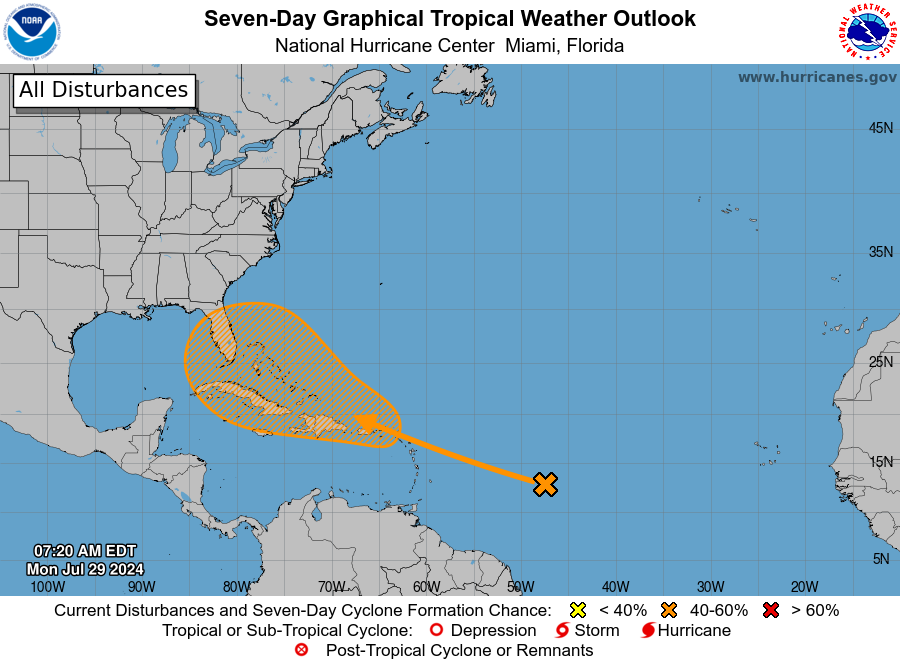Hurricane season ramps back up as Saharan dust effects subside. Here's what to know
The effects of a large plume of Saharan dust that had momentarily curbed the development of tropical storms within the Atlantic Ocean have begun to subside, paving the way for the 2024 Atlantic hurricane season to begin ramping back up.
The National Hurricane Center (NHC) has begun tracking an "area of disturbed weather" from the Leeward Islands to Florida that it says could develop into a tropical cyclone.
A tropical wave is forecasted to catch up with the area, which the NHC says could create an environment conducive to development. The area has a 50% chance of becoming a tropical cyclone over the next seven days.
"Especially with La Niña starting to develop we're going to be seeing a lot more tropical systems developing here," AccuWeather Senior Meteorologist Alan Reppert told USA TODAY on Sunday. "We did predict that there would be at least some break here until the early part of August when we start to see more chances and more threats for development."
Where is the latest tropical disturbance that could impact Florida?

Right now the area of disturbed weather is near the Leeward Islands and Greater Antilles. It is expected to interact with an approaching tropical wave within the next few days, according to the NHC.
Where could the tropical disturbance head once it's formed?
It's too early to give any idea of a concrete path the potential cyclone would take. However, FOX Weather hurricane specialist Bryan Norcross, in his Hurricane Intel column, said "possible paths range from east of Florida to a track into the Gulf of Mexico to dying over the mountainous islands. Obviously, there are a number of steps to watch for with this system."
2024 Atlantic hurricane season outlook for Florida
Forecasters have maintained this year will be a busy hurricane season, despite the mostly quiet month of July. Colorado State University increased its number of named storms for the season that runs through Nov. 30 to 25, from 23 forecast June 1. Researchers noted Hurricane Beryl, which made landfall in Texas on July 8, as one reason for the increase.
The Atlantic hurricane season begins to ramp up in early August with a peak date around Sept. 12 as ocean waters typically reach their warmest temperatures of the year and wind shear calms. The basin remains active through mid to late October before starting to cool off in November.
"Floridians should be prepared for what may be a very long and trying few months," said Jeff Masters, co-founder of Weather Underground and a meteorologist for Yale Climate Connections, in a June interview. "Conditions are ripe for a bonkers hurricane season."
What’s a tropical disturbance?
Tropical disturbances are basically a cluster of thunderstorm clouds. The clouds begin to release heat, columns of warm air begin to form as the air rises, and these columns continue to grow higher and bigger. As air pressure begins to shift, a creating a whirlpool effect.
What’s a tropical depression?
A tropical depression is the next step of the process and this is when we begin to see stronger winds. This is caused by those columns of air continuing to become stronger and larger.
When the warm vapor rises to the top of the clouds and cools down, the heat it once held has to go somewhere. In this case, that heat energy is released into the air at the top of the clouds, which makes the air pressure higher. That pressure begins pushing out into the surrounding areas of low pressure, creating those stronger winds and what is essentially a loop that creates more thunderstorms.
What is a tropical cyclone?
A tropical storm becomes a tropical cyclone, or a hurricane, once sustained wind speeds reach 74 mph. At this point, the storm is massive. According to NOAA, hurricanes are at least 50,000 feet high and 125 miles across. The eye alone can range between 5 and 30 miles wide.
From here, when a hurricane continues to strengthen, we refer to the Saffir-Simpson Hurricane Wind Scale.
This article originally appeared on Pensacola News Journal: Potential cyclone eyes Florida. Here's what we know right now

